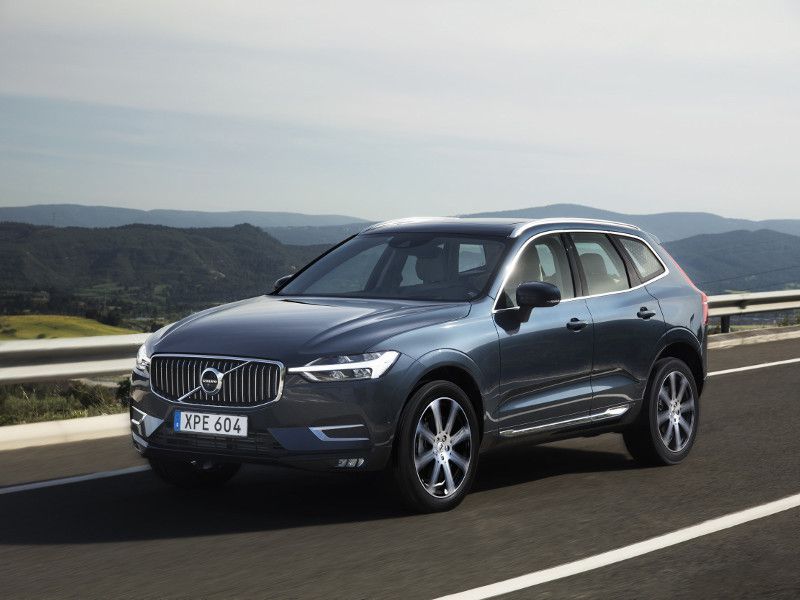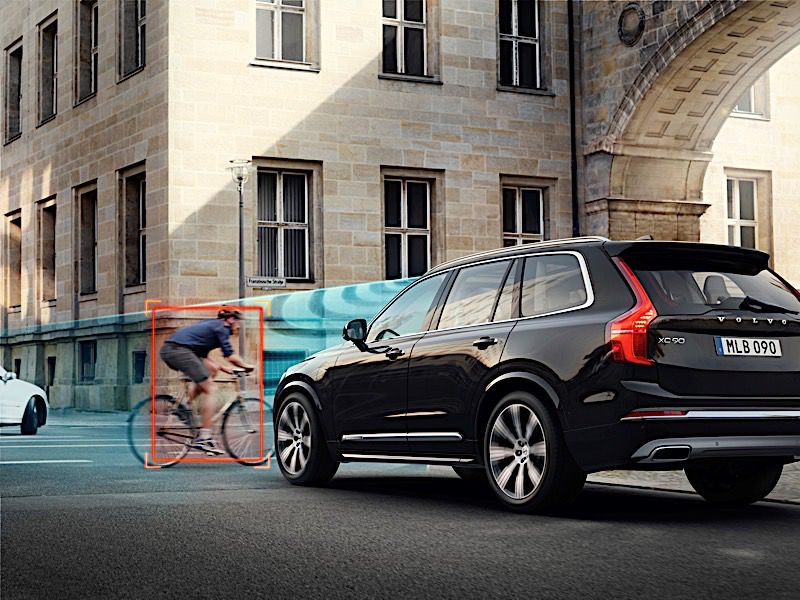Recent Articles
Popular Makes
Body Types
Volvo's Pilot Assist Overview

2020 Volvo XC60 in the city ・ Photo by Volvo
Every automaker wants to make safer cars. To achieve that goal, automakers have been developing and deploying advanced driver-assistance systems (ADAS) to give drivers the best chance to avoid situations that are likely to result in collisions. These systems include automatic features that help drivers maintain safe speeds and distances between vehicles.
As a leader in automotive safety, Volvo has also been at the forefront of research into ADAS. Volvo has a few trade names for its ADAS, including IntelliSafe Assist and Pilot Assist. These systems implement limited driver assistance in many Volvo models sold over the past several years. Keep reading to learn more about Volvo’s Pilot Assist, Park Assist Pilot, and other advanced safety and convenience features.
What is Volvo Pilot Assist?
Volvo Pilot Assist is a name given to an adaptive cruise control and lane-following system available on all new Volvos, either as standard equipment on higher trim levels or in an option package. Pilot Assist is able to assist with steering and can adapt to prevailing traffic flow at speeds up to 80 mph.
Pilot Assist uses a camera and radar system mounted high on the windshield, just in front of the rearview mirror. The camera and radar detect lane markings and other vehicles, providing information to the Pilot Assist system (if equipped) and the general safety systems. Pilot Assist is also integrated with the Volvo’s GPS navigation system to increase its accuracy and proactive performance in holding steering around a curve.

Photo by Volvo
Adaptive Cruise Control
Volvo’s adaptive cruise control is the heart of Pilot Assist. Using the camera and radar system, the Pilot Assist system allows the driver to set a desired speed. The cruise control will not exceed that speed, but it will slow the vehicle if required to maintain a minimum following distance to the next vehicle. The system follows the prevailing speed of traffic, including stop-and-go periods.
Volvo’s system is more advanced than many other brands, because it also allows the driver to set a desired time interval to the vehicle ahead, as well as simple distance. This allows the Volvo to adjust its following distance based on speed. That helps avoid creating gaps in traffic. The time interval also ties into the following distance warning function.

Photo by Volvo
Pilot Assist Lane Following
The feature that really defines Pilot Assist is the automated lane following. Using a combination of the camera and radar system, augmented by data from the GPS navigation system, the Volvo will assist the driver with gentle steering inputs to keep the vehicle centered in its lane around curves. To activate the feature, the Pilot Assist system must be active.
It’s important to note that Pilot Assist does not make any Volvo into a self-driving vehicle. The driver must always keep both hands on the steering wheel and his or her attention on the road ahead. The human driver is still responsible for the path of the vehicle. Also, the Pilot Assist system relies on clearly visible lane markings, so places where the markings are worn or nonexistent can cause the Volvo to drop out of Pilot Assist.

Photo by Volvo
Park Assist Pilot
Park Assist Pilot is a related technology to Pilot Assist. This system allows the Volvo to park itself in parallel or perpendicular parking spaces. Park Assist Pilot works through the Sensus Connect infotainment system, and when activated, it will scan for available parking spaces big enough to accommodate the vehicle. When a suitable space is detected, the system notifies the driver.
The system allows the driver to select parallel or perpendicular parking. For parallel parking, the driver places the vehicle in reverse. The Volvo will handle its own steering to guide itself into the space, but the driver must still use the brake pedal to stop. The system may not function as designed on curved roads, or when the curb is uneven. Volvo is clear that the responsibility for safe parking still resides with the driver.

Photo by Volvo
Standard Advanced Volvo Safety Systems
All new Volvo vehicles come with a premium set of safety features, including lane-keeping assistance, oncoming lane mitigation, and run-off road mitigation. These three advanced features on their own place any new Volvo among the safest vehicles on the road.
Lane-keeping senses if the driver allows the vehicle to drift to the edge of its lane, and gently steers the Volvo back to the center. Oncoming lane mitigation is similar, but it's more forceful if it detects that the vehicle has actually crossed the lane markings into the path of an oncoming vehicle. Run-off road mitigation works if the Volvo is headed off the paved road entirely. This often happens in bad weather and can result in serious injuries. The Volvo steers itself back onto the road, while also tightening the driver and front passenger seatbelts in case the unintended off-road excursion cannot be avoided.

Photo by Volvo
Additional Feature: Blind Spot and Rear Cross-Traffic Alert
In addition to the advanced systems that implement Pilot Assist and Park Assist Pilot, Volvo offers blind-spot monitoring and rear cross-traffic alerts as standard equipment on higher trim vehicles, and as part of an option package on base trims. Blind-spot monitoring uses radar sensors on either side of the vehicle to monitor when other vehicles are overtaking or riding in the Volvo’s blind spot. A visual signal is employed to let the driver know it’s not safe to move over.
The same system also looks to the side when you’re backing out of a parking space. With today’s larger vehicles, it’s frequently impossible to see a vehicle coming down the lane as you back out. The rear cross-traffic alert tells you when someone’s coming, making parking maneuvers a little less stressful.

Photo by Volvo
Additional Feature: Road Sign Information
The forward-facing camera on a new Volvo can do more than spot vehicles ahead. The system can also read road signs and display important information such as speed limits on the vehicle’s driver information display or the head-up display, if the Volvo has that equipment.
However, the system is not always perfect. Signs that are obscured or faded may not be recognized correctly. The system cannot always read signs on sharp curves, depending on the sign’s location. Volvo emphasizes that the human driver is always responsible for maintaining legal and safe operation of the vehicle.

Photo by Volvo
Additional Feature: Volvo City Safety
Volvo City Safety is designed to help keep the driver and passengers safe, but also to protect people outside the vehicle. If the Volvo is approaching another vehicle and a collision seems likely, the system first warns the driver to apply the brake. If the driver fails to apply the brakes, the Volvo will automatically stop. The system is capable of stopping the Volvo at low speeds, or reducing speeds to mitigate damage.
new Volvos also offer steering support, which can allow the vehicle to steer around an obstacle if it cannot stop in time. Volvo City Safety is capable of detecting other vehicles, bicycle riders, pedestrians, and large animals, even at night. City Safety is one of the core safety features of a Volvo.

Photo by Volvo
Additional Feature: Rear Collision Warning
Another area where Volvo is leading on safety is in rear collision warnings. Using the rearward-facing radar — if another vehicle is approaching from behind and the Volvo determines that a collision is likely — the Volvo will alert the approaching driver by flashing its hazard lights.
If the oncoming vehicle does not brake, the Volvo will tighten the driver’s and front passenger’s seatbelts and activates the vehicle's brakes to help prevent a secondary collision. These actions help to reduce the potential for injuries even when the collision cannot be avoided.

Photo by Volvo
Why Volvo Pilot Assist Is Important
Years ago, Volvo articulated an ambitious goal: that no one should be killed or seriously injured when riding in its vehicles. Features like Pilot Assist and City Safety are part of the technology that Volvo has developed to bring that dream a little closer to reality.
Pilot Assist has been developed through several generations since Volvo first put the system into production, and it will continue to develop over time. To experience Volvo’s safety features for yourself, visit a Volvo dealer and ask for a demonstration.

Photo by Volvo